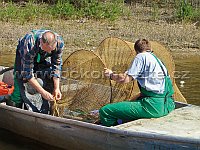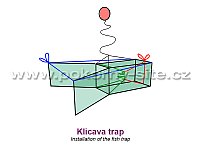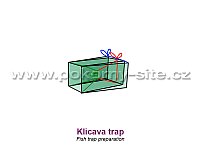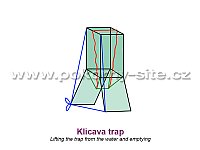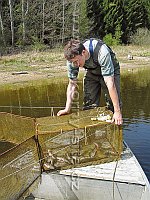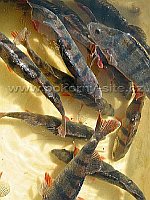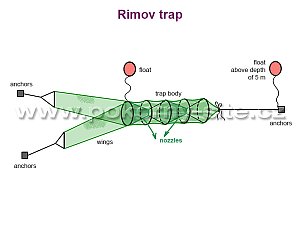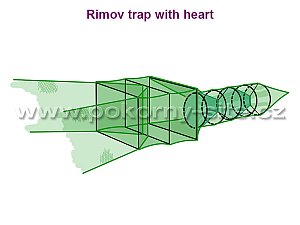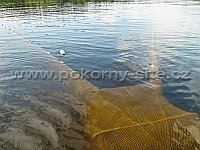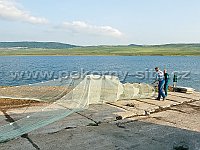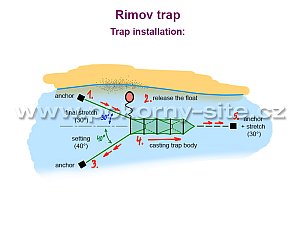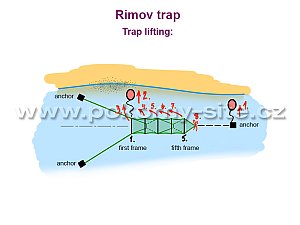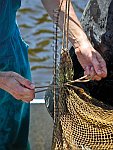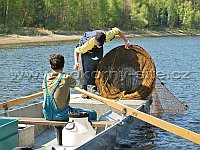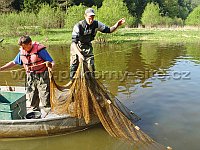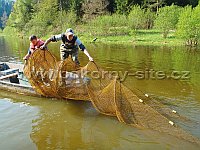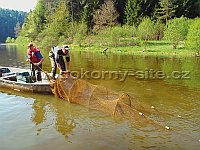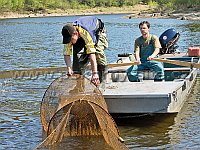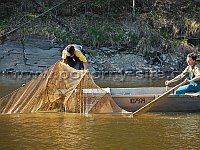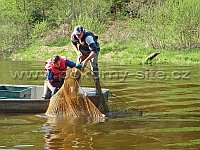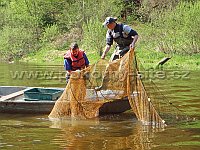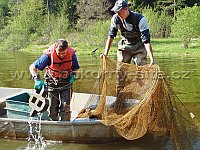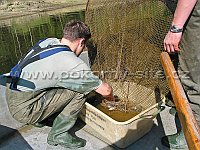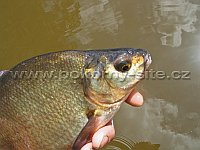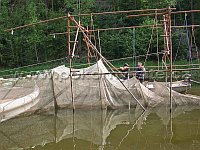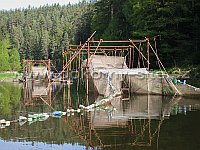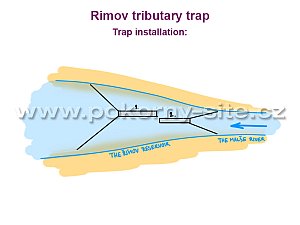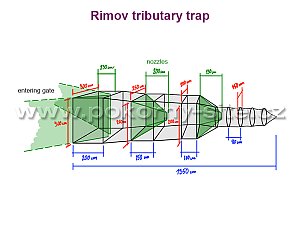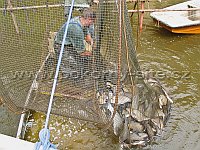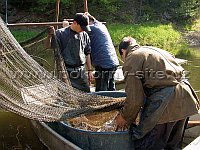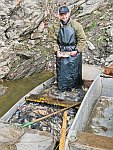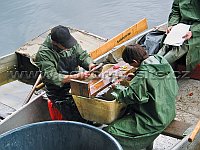Fishing nets - Passive fishing gear
Fish traps
- fish traps belong to passive fishing gear
- fish are caught by their actively swimming into the body of the fish trap, which results in their capture
Principles of fish trap
- fish trap – the wings of a fi sh trap makes a barrier in the lentic or lotic water
- fish runs into the wings and swims into the body of the fish trap
- nozzles are part of the trap – funnel-shape part at the entrance part of the trap
- nozzles – funnel-shape disable fi sh from escaping the fi sh trap
Usage
- sampling fi sh and commercial fishing in lentic and lotic waters
- shape and size is adjusted to the fishing location
- shape and size is adjusted to the targeted fish species
- different fish trap are variously selective when fishing in the same locality
Our standard range of fi sh traps includes several tested types with a broad scale of chambers ranging from 0.1 to 100 m3.
Traps use for scientific sampling and fisheries
display / hide whole profile
prof. RNDr. Jan Kubečka, CSc.
 My scientifi career is associated with the Institute of hydrobiology of the Academy of Sciences CR and focuses on research into the ecological role of fish community in reservoirs and lakes. I participated in methodological development of many fishing techniques and gears, which are useful in large water ecosystems – beach seine nets, gillnets, trawls, purse seine nets, fish traps, scientific echosounders, usage of electrofi shing etc.
My scientifi career is associated with the Institute of hydrobiology of the Academy of Sciences CR and focuses on research into the ecological role of fish community in reservoirs and lakes. I participated in methodological development of many fishing techniques and gears, which are useful in large water ecosystems – beach seine nets, gillnets, trawls, purse seine nets, fish traps, scientific echosounders, usage of electrofi shing etc.
Technical improvements were tested many times in the Czech Republic as well as abroad Thanks to the 30-year development of sampling methodologies, it is nowadays possible to achieve a quite accurate quantitative picture of composition and distribution of fi sh communities, when robust methods such as multimesh gillnets, trawls and beach seine nets are used correctly. The unfortunate and sad result of this sampling is its effect on fi sh life and the frequent mortality of captured fi sh. This is one of the reasons why a substantial part of my scientific career is dedicated to the development of indirect fi sh study, particularly the use of scientific echosounders.
Fish traps are quite a gentle way to sample fish
First, I worked with fi sh traps during my diploma thesis at the Faculty of Science, Charles University in Prague, which dealt with fi sh fry communities in the Klíčava Reservoir. Klíčava traps were specially developed for this reservoir and were effective especially for sampling perch (Kubečka & Švátora 1993). When I started to work at the Institute of Hydrobiology of the Academy of Sciences CR, I developed larger fi sh traps together with a net builder named František Hamr. These fish traps were then used for mark-recapture studies and biomanipulation purposes. They were named after the main locality of usage – medium trap. They have been used in a nearly unchanged design for almost 30 years.
An ambitious project was completed at the turn of the 20th century
The importance of tributary zone for fi sh community of the reservoir was studied in cooperation with Pokorný – Sítě company. We developed two specially designed giant traps which were able to examine whole fish migration between the Římov Reservoir and its main tributary, the Malše River (Hladík et al. 2002). These two traps were installed during migration period for four years and their use enriched our knowledge about migration of fi sh between reservoir and river (Hladík & Kubečka 2003, 2004, Hladík et al. 2008, Říha et al. 2013).
Klíčava traps, standard Římov traps and modifi ed Římov traps with heart have recently been used in sampling of fi sh communities in Římov Reservoir and post-mining lake Milada (Říha & Kočvara, personal communication; Peterka et al. 2012).
Contact: kubecka@hbu.cas.cz
References:
Klicava trap
Klicava trap was originally developed for perch sampling in the Klicava and Záskalská Reservoirs. Traps were successfully used for biomanipulation in Římov Reservoir (Kubečka, 1992).
Usage:
- Klicava trap – successful sampling of small benthic fish species
- useful for fi sh species dwelling in macrophytes – perch, European eel, burbot, gudgeon, tench, pike
- the smallest standard and commonly used type of fish trap
Advantages:
- small size, weight and price
- easy to store
- self-supporting construction
- ready to sample immediately – no need to adjust wings after installation
- installation into any arbitrary depth and also into locations with limited space
- installation on the steep slope of the bank
- installation into structured environment (e.g. submerged tree stumps, etc.)
- easy manipulation by one person – installation and removal of catch
- catch remains in good condition for a long time after capture
- depending on water temperature, remove the catch every 3 to 7 days
Disadvantages:
- high selectivity
- does not catch species such as bleak, roach, bream
Instructions for use
- Fish trap preparation
- wings are tied to the main body with wing stretching cord for transport
- fix wings in the front of the trap entrance in a V-shape (angle 30 – 40°)
- use wing stretching cord (part of the trap) to fix the wings
- stretching cord starts and ends at the edge of the right wing
- nozzle is stretched using inner stretching cord
- trap has 3 suspension points and lifting cord with the float for installation
- trap has to be in a horizontal position after lifting it in the air
- install the trap in water in a horizontal position
- Installation of the fish trap
- wings must be at an angle of 30 - 40°
- the trap is installed in set position – ready to catch fish
- the trap is casted into the water using the lifting cord with the float
- the trap is installed on the bottom
- install the trap parallel to the shore when the slope is steep
- it is suitable to use this trap type when the slope is no steeper than 50°
- cast the trap vertically to avoid getting stuck or overturning the trap
- Lifting the trap from the water and emptying
- Klicava trap can be emptied every 3 to 7 days
- trap is lifted above the water level using the lifting cord with the float
- lay the trap on the boat and untie the nozzle stretching cord
- untie the wing stretching cord for better comfort (not necessary)
- place the trap into vertical position bottom-up
- use the nozzle oriented right side out to empty the fish caught into the prepared vat filled with water
- it is suitable to wash the trap from algae before recasting in the water
- wash by quick vertical moves of the trap in the water column
Sizes:
- body – 40 x 40 x 80 cm
- wing length - 80, 120 cm
- mesh sizes 6, 10, 15 mm
Design:
- frame made from metal wire
- wire diameter 6 mm
- wings are attached via hinges
- powder coated – green
- polyamide knotless net with the diamond-shaped mesh
- mesh sizes 6, 10, 15 mm
- thread thickness – 210/6 – 210/18
- net is stretched and sewn to the frame
- trap has one nozzle
- nozzle has a cord attached for stretching and emptying the trap
- 3 suspension point designed for casting the net horizontally
- 10 m lifting cord with the float
Klicava trap is made in time-t tested design and sizes
| MESH SIZE (in mm) | WIDTH (in cm) | HEIGHT (in cm) | BODY LENGTH (in cm) | WING LENGTH (in cm) |
|---|---|---|---|---|
| 6, 10, 15 | 40 | 40 | 80 | 80 |
| 6, 10, 15 | 40 | 40 | 80 | 120 |
Keep in mind the following ethical standard - a fish trap lost is still fishing
- use our gillnet finder for finding and lifting a lost trap.
Rimov trap
Used on many occasions in large water bodies in the Czech Republic as the main tool for biomanipulation with perch (Kubečka 1992, Seďa & Kubečka, 1997)
Usage:
- Rimov trap – successful in catching benthic species
- useful for fi sh species dwelling in macrophytes
- perch, European eel, burbot, gudgeon, tench, pike, pikeperch, catfi sh etc.
- designed for large water bodies with gentle slope of the bank (up to 20°)
- many shape and size modifi cations available
- chamber volumes: 0.1 – 100 m3
Advantages:
- easy to store
- possible to install at depths (up to 20 m)
- catch remains in good condition for long time
- depending on water temperature, remove the catch every 3 to 7 days
Disadvantages:
- underestimation of catch of certain fish species (Kubečka, 1992)
Underestimation was solved by adding another nozzle to the Rimov trap.
Sizes:
- steel ring diameter 90 cm
- body length – 4 or 6 m
- number of nozzles – 2
- wing height – 90 – 120 cm
- wing length – 10 m
Design:
- rings made from steel wire
- wire diameter 8 mm
- powder coated
- body – cylindrical net with two nozzles
- polyamide knotless net with diamond-shaped mesh
- mesh sizes - 15, 20 mm
- thread thickness 210/18
- wing length: 5 – 10 m
- wings have floats and weights
- lifting cord with the float
- stretching cords for attaching anchors and rods
Rimov trap is made in standard design a and its modififi cations.
| MESH SIZE (in mm) | DIAMETER (in m) / NUMBER OF FRAMES | NUMBER OF NOZZLES | WING LENGTH (in m) | NUMBER OF WINGS |
|---|---|---|---|---|
| 15, 20 | 0.4 x 0.4 m / 5 – Square-shaped | 2 | 5 - 10 m | 2 |
| 15, 20 | 0.4 m / 5 – Ring-shaped | 2 | 5 - 10 m | 2 |
| 15, 20 | 0.6 m / 5 – Ring-shaped | 2 | 5 - 10 m | 2 |
| 15, 20 | 0.7 m / 5 – Ring-shaped | 2 | 5 - 10 m | 2 |
| 15, 20 | 0.9 m / 5 – Ring-shaped | 2 | 10 m | 2 |
Rimov trap with heart
It is a modifi cation of the Rimov trap. A larger nozzle was added in front of the heart, which forms the fi rst part of the trap body.
Advantages:
- the modification results in non-selective fish sampling
- cyprinid fishes are also caught in this type of fish trap
- the data obtained with this gear can be considered to be a representative sample (kubečka 2007)
Rimov trap with heart is made in a time-tested design and size
| MESH SIZE (in mm) | DIAMETER (in m) / NUMBER OF FRAMES | NUMBER OF NOZZLES | WING LENGTH (in m) | NUMBER OF WINGS |
|---|---|---|---|---|
| 15, 20 | 1.2 m / 3 ks 0.9 m / 5 pieces 1.2 m / 3 pieces 0.9 m / 5 pieces | 3 | 5 - 12 m | 2 |
Instructions for use:
General principles
- cast the trap from a row boat powered by oars
- stretch the trap with poles or 3 (metal, concrete or stone) anchors
- it is possible to install the trap to maximal depth of 20 m
- optimal depth is 10 m or less
- cast the trap parallel to the shore
- Rimov trap is installed on unstructured bottom with gentle slope up to 20°
- successful fi shing – set the wing angle at 30-35° to the trap center line
- trap has to be stretched precisely with three fi xed points
- trap lifting:
- fi rst lift the back anchor
- lift the trap using the fi rst frame with the fl oat
Only a correctly set fish trap catches fish!
- Easier to empty traps with two persons.
- Pay attention to the trap wings not turning over or deform during emptying the trap.
- If anchors move during fish removal, it is necessary to lift the whole trap and set it again.
- Folding trap to the boat
- carefully tie the end of the trap before folding
- fold the trap on the foredeck
- start with last frame of the trap body and end with the front frame with wings
- fold wings on the front frame separately
- fold stretching cord for wings last
- floats are oriented towards the stern and anchors towards the foredeck
- Trap installation using anchors
- find a suitable and sufficiently large location
- attach an anchor of at least 15 kg to both stretching cords of the wings
- throw the nearshore anchor into the water first
- estimate a 70° angle to the shore and row in this direction – stretch the stretching cord and cast the wing into water
- after the wing has been stretched, cast a sufficiently long cord with the float attached to the front frame
- cast the trap body in desired direction
- leave the second anchor on the boat and turn the boat in the direction in which the second wing will be casted
- stretch the second wing and pay attention to setting the wing angle at 30-35° to the trap center line
- place the anchor in the water - the second wing has to be mildly stretched
- row to the trap body and lift it using the lifting cord with the float stretch the body on the board and ensure that the frames are not twisted
- attach the anchor to the rear stretching cord and lay it into the boat
- throw the float and lifting cord of the front frame in the water
- stretch the trap body and place it in the water accordingly to the position of both wings and their anchors
- the body and wings of the trap must not be twisted or deformed in any way
- the rear anchor attached to the stretching cord of the trap body is placed in the water last
- check if the trap is stretched even after throwing the anchor in the water
- attach the cords with floats to the trap that is placed at depth – the floats have to form the letter “Y” if installed correctly
- after final stretching of the main body, the angle decreases from the original 40° to the intended 30° - 35°
- Trap lifting and removal of the catch
Klicava trap can be emptied every 3 to 7 days
- possible to lift the trap placed at a maximum depth of 5m by using the lifting cord with the fl oat attached to the fi rst frame of the trap
- if deeper, start by lifting the rear anchor attached to stretching cord, followed by lifting the fi rst frame of the trap
- lift above the water level on the bow and add other frames
- when lifting the trap, shake the catch to the rear of the trap
- once all frames are on the boat and fi sh are in the rear of the trap, untie the trap outlet and empty the catch into the prepared vat
- tie the trap and set again
- we recommend cleaning the trap by dragging through the water to remove algae and alluvium
- Only a clean trap is effective! A dirty trap is visible and does not catch fish!
Rimov tributary trap
Tributary trap was used for monitoring fi sh migration between the Římov Reservoir and its main tributary – Malše River.
Two fish traps were installed close to each other in the tributary of the reservoir.
- the first was oriented towards the dam part of the Římov Reservoir
- the second was oriented towards the tributary part
Sizes:
- entrance 3 x 3 m
- trap length 13.5 m
- entrance part – 1 piece
- number of nozzles – 2
- wing height – 3 m
- wing length – 25 m
Design:
Frame:
- entrance – metal square tube 30 x 30 mm
- pot – wire rings
- wire diameter 12 mm
- colored surface
Net:
- polyamide knotless net with diamond-shaped mesh
- mesh size 15 mm
- thread thickness 210/18
- wing length – 25 m
- wing has floats and lead line attached
Trap was supported with a metal self-supporting frame, which was used to:
- support and anchor the frame in the current
- support the frame for fish removal
- support the frame for cleaning of algae and for trap reparation
Fish caught were removed twice a week or more frequently into a floating cage and then scientifically processed.
Tributary fish traps capture all kinds of migrating fish (Hladík et al. 2002).
Mark and recapture of fish using Rimov tributary traps belongs to the largest marking experiments in history of the Czech ichthyologic.
- more than 50 thousand migrating fi sh were captured and marked
- whole season monitoring showed that most of fi sh migrate into the river for spawning and return into the reservoir relatively soon after spawning
- populations of fi sh such as asp, white bream, chub migrate into the tributary for spawning
- species such as roach, bream and perch migrate only from adjacent part of the reservoir
- the smallest migrating distance was observed for pike and perch
- on average, one fi fth of the whole reservoir population migrates into the tributary
Rimov tributary traps can be used for biomanipulation with purposes.
